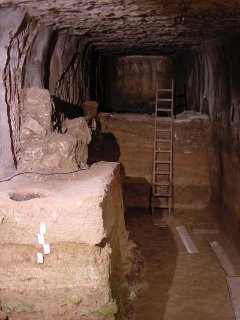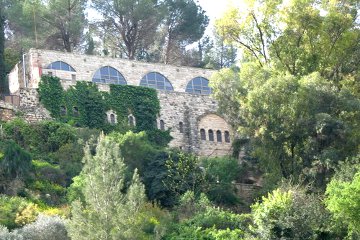The Baptist's Cave
| Ain Kerim | 31 46 02.59N 35 09 45.15E | You really would think Google Earth could come up with better pictures for Israel! You can't even make out the church with any certainty. |
| St John Monastery | 31 46 02.42N 35 07 49.99E | Again, the picture is too poor to show any detail. I found this site by accident while cycling around Ein Kerim. |
Recent reports of the finding of the cave of John the Baptist have sparked off considerable controversy. The cave was first found in November 1999 and excavated between 2000 and 2003 by Dr Shimon Gibson and Dr James Tabor on behalf of the University of North Carolina. These men deliberately kept quiet about their find in order to allow the work of excavation to proceed unhindered.

| |
| The interior of the cave of John the Baptist. The tanks in the cave probably have a ritual purpose. |
The original discovery took place during a surface survey of the hills around Ain Kerim, west of Jerusalem, and Dr Gibson had to wriggle through a tiny hole in the ground in order to enter the cave. When cleared, however, it was found that the cave was a man-made hole in the ground some 75 feet long, 12 feet wide and 15 feet high. The walls had been lined with plaster, mixed in with which were fragments of pottery and charcoal. The pottery was of the Iron Age style and the date was confirmed by C-14 dating of the charcoal, indicating that the cave was first built - or first inhabited and used - around 600 BC.
The cave, approached by twelve steps, contained a number of stone circles, three feet in diameter, surrounded by large quantities of broken pottery. At the entrance there are two rectangular basins which were supplied with water from the nearby valley. The excavators' report also makes cryptic reference to "a foot anointing installation" - your guess is as good as mine.
However it is clear that the cave was, from the beginning, used for ritual or religious purposes. The main phase of occupation was from the 1st century BC to the 2nd century AD and as the traditional home of John the Baptist was in Ain Kerim, it is virtually certain that as a boy he would have been aware of this place, if not actually involved in whatever went on there.
The usual sceptics have poured scorn on Dr Gibson's report. To them, anything that bears the slightest connection with the Bible has to be demolished or explained away. Certainly there is a tendency in Dr Gibson's book, "The Cave of John the Baptist" to over-interpret the site and some of the suggestions for the type of activities that went on there are highly imaginative, to say the least.

| |
| The monastery of St John in the Wilderness stands above the village of Ain Kerim. |
Having said that, however, it is almost certain that people in the Byzantine period associated the cave with John the Baptist. There is a nearby monastery of John the Baptist, Ain Kerim is the prophet's traditional birthplace and a location near the Ain Kerim hospital is claimed to be the "wilderness" in which John grew up. Inside the cave there is a crude figure scratched into the plaster that almost certainly is intended to represent John the Baptist accompanied by the Agnus Dei.
No one can doubt Dr Gibson's competence or his scholarly credentials and, to give him further credit, he deliberately left a third of the cave unexcavated for the benefit of future archaeologists who, with better equipment and techniques, might be able to extract even more information from the site.
It is highly unlikely that John the Baptist actually lived in this cave or preached from it. Biblical tradition places his adult life and activities firmly down by the Jordan. However it is highly likely that he lived and grew up in this area and therefore knew of or visited this cave. It is, of course, possible that those who scratched his figure in the plaster may have known of a closer connection between the prophet and the site, a relationship which is now lost.





